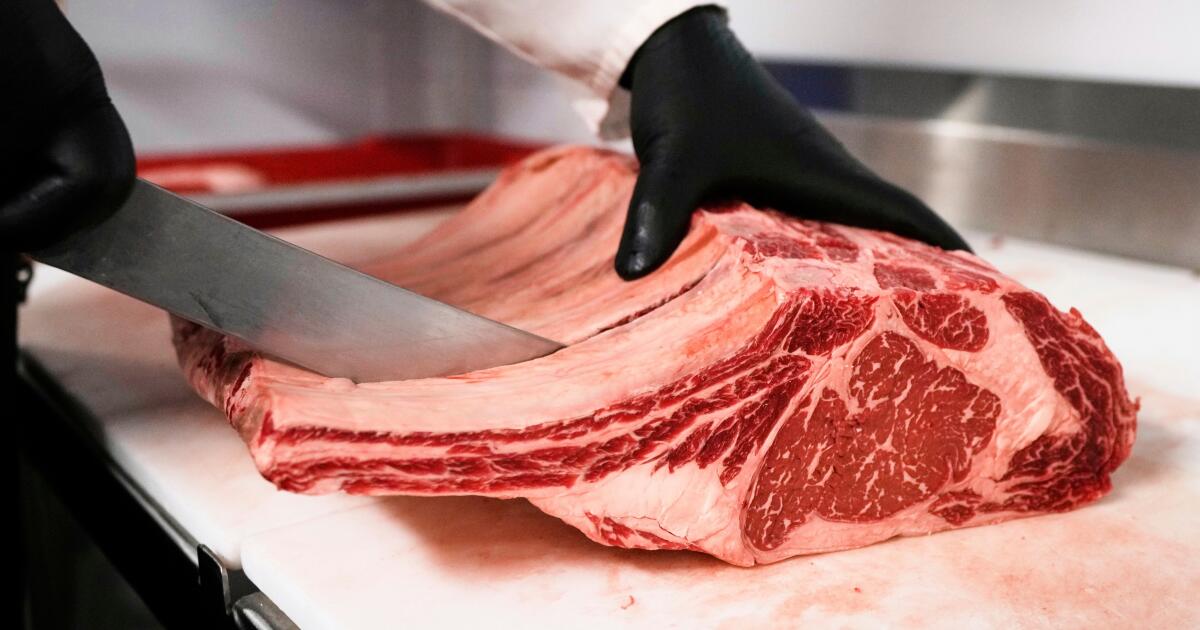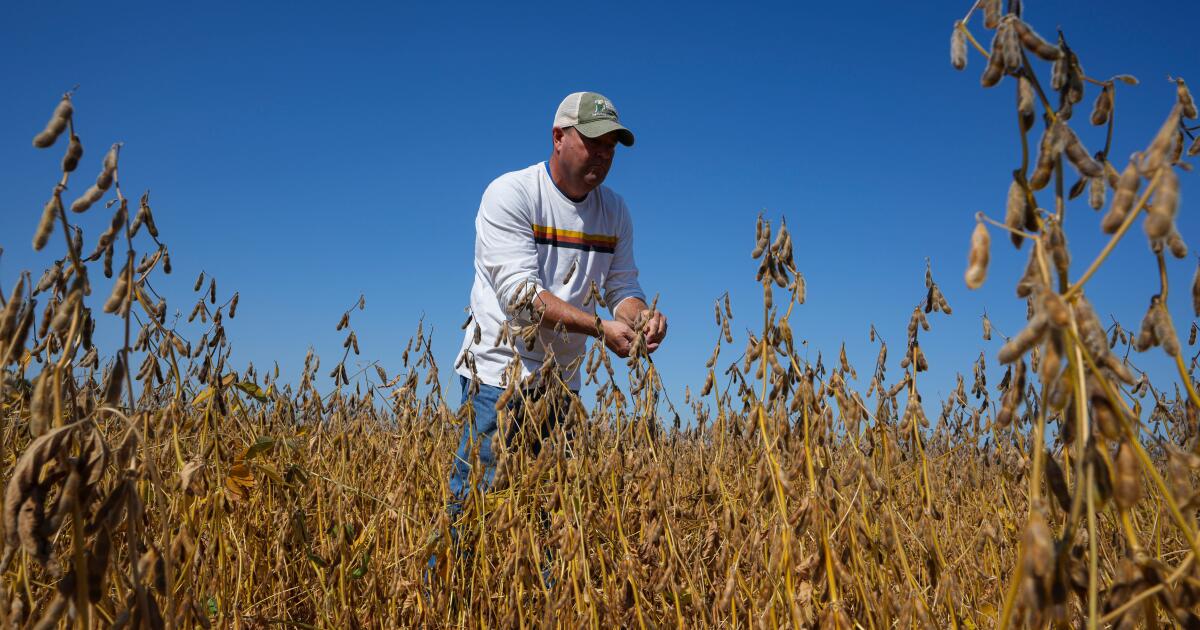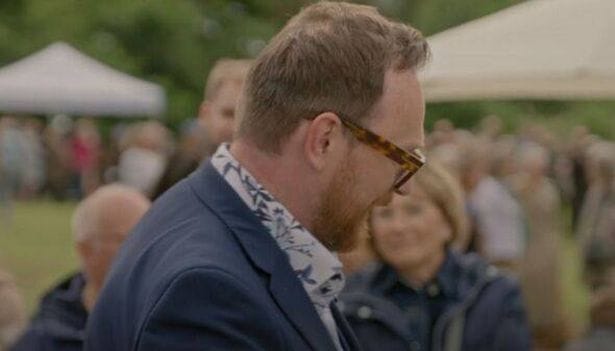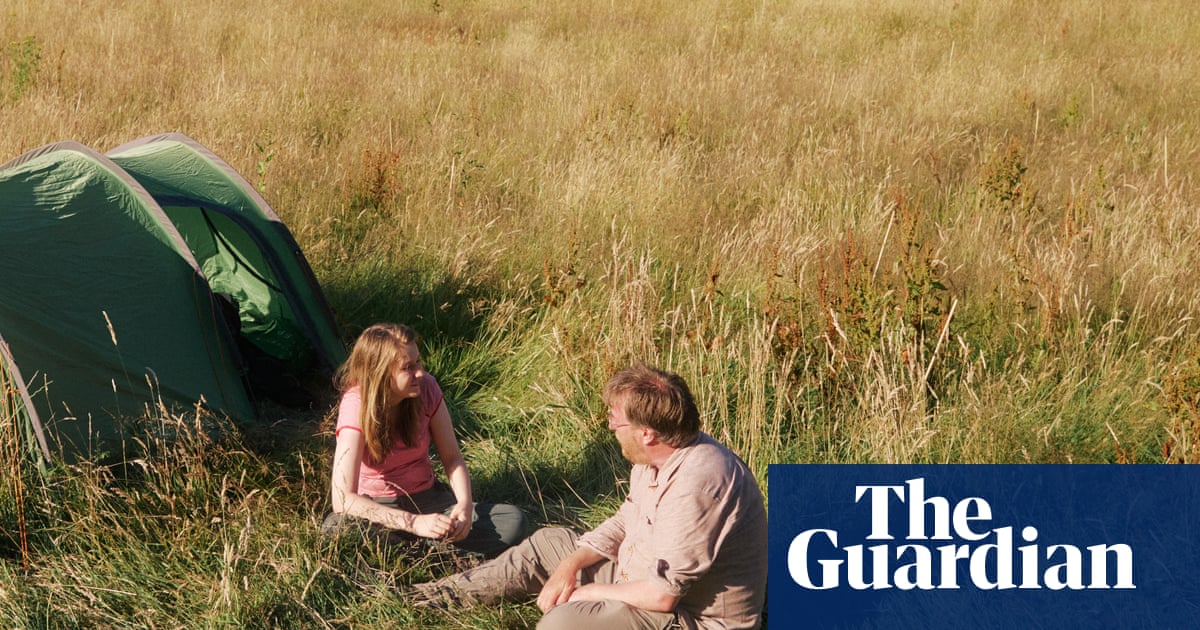MAGNOLIA, Ky. — The leafy soybean plants reach Caleb Ragland’s thighs and are ripe for harvest, but the Kentucky farmer is deeply worried. He doesn’t know where he and others like him will sell their crop because China has stopped buying.
Beijing, which traditionally has snapped up at least a quarter of all soybeans grown in the U.S., is in effect boycotting them in retaliation for the high tariffs President Trump has imposed on Chinese goods and to strengthen its hand in negotiations over a new overall trade deal.
It has left American soybean farmers fretting over not only this year’s crop but the long-term viability of their businesses, built in part on China’s once-insatiable appetite for U.S. beans.
“This is a five-alarm fire for our industry,” said Ragland, who leads the American Soybean Assn. trade group.
The situation might even be enough to test farmers’ loyalty to Trump, although the president still enjoys strong support throughout rural America. If no deal is reached soon, farmers hope the government will come through with aid as it did during Trump’s first term, but they see that as only a temporary solution. Trump said Thursday he was considering an aid package.
U.S. and Chinese officials have held four rounds of trade talks between May and September, with another likely in the coming weeks. No progress on soybeans has been reported.
Getting closer to harvest, “I’m honestly getting worried that the time is running out,” said Jim Sutter, chief executive of the U.S. Soybean Export Council.
Political pressure is growing
After Trump imposed tariffs on Chinese goods, China responded with tariffs of its own, which now total up to 34% on U.S. soybeans. That makes soybeans from other countries cheaper.
China’s retaliatory tariffs also hit U.S. growers of sorghum, corn and cotton; and even geoduck divers have been affected. But soybeans stand out because of the crop’s outsize importance to U.S. agricultural exports. Soybeans are the top U.S. food export, accounting for about 14% of all farm goods sent overseas.
And China has been by far the largest foreign buyer. Last year, the U.S. exported nearly $24.5 billion worth of soybeans, and China accounted for more than $12.5 billion. That compared with $2.45 billion by the European Union, the second-largest buyer. This year, China hasn’t bought beans since May.
With U.S. farmers hurting, the Trump administration is under growing pressure to reach a deal with China. As talks drag on, Trump appears ready to help.
“We’re going to take some of the tariff money — relatively small amount, but a lot for the farmers — and we’re going to help the farmers out a little bit,” Trump said, during what he called a transition period.
The only way most farmers survived Trump’s trade war in his first term was with tens of billions of dollars in government payments. But that’s not what most farmers want.
What farmers expect from Trump
“The American farmer, especially myself included, we don’t want aid payments,” said Brian Warpup, 52, a fourth-generation farmer from Warren, Ind. “We want to work. We work the land, we harvest the land, the crop off the land. And the worst thing that we could ever want is a handout.”
Farmers are looking to Trump for a long-term solution.
“Overwhelmingly, farmers have been in President Trump’s corner,” said Ragland, the president of the soybean association. “And I think the message that our soybean farmers as a whole want to deliver is: ‘President Trump, we’ve had your back. We need you to have ours now.’”
He said farmers appreciate the willingness to provide some short-term relief, but what they ultimately need are strong, reliable markets. “Our priority remains seeing the United States secure lasting trade agreements — particularly with China — that allow farmers to sell their crops and build a sustainable future with long-term customers,” he said.
Ragland, 39, hopes his three sons will become the 10th generation to till his 4,500 acres in Magnolia, Ky. Unless something changes soon, he worries that thousands of farmers may not survive.
Coming into this year, many farmers were just hoping to break even because crop prices were weak while their costs had only increased. Trump’s tariffs, which helped make their crops uncompetitive around the world, drove prices down further. And tariffs on steel and fertilizer sent costs up even more.
Darin Johnson, president of the Minnesota Soybean Growers Assn., said he still has faith in the Trump administration to reach a good trade deal with China.
“I think where the patience is probably wearing thin is the time,” said Johnson, a fourth-generation farmer. “I don’t think anybody thought that we were going to take this much time, because we were told 90 deals — 90 deals in 90 days.”
China’s negotiating strategy
The U.S. soybean industry grew in response to Chinese demand starting back in the 1990s, when China began its rapid economic rise and turned to foreign producers to help feed its people. Protein-rich soybeans are an essential part of the diet.
While China relies on domestic crops for steamed beans and tofu, it needs far more soybeans for oil extraction and animal feed. In 2024, China produced 20 million metric tons of soybeans, while importing more than 105 million metric tons.
American farmers have come to count on China as their biggest customer, and this has “given the Chinese a point of leverage,” Sutter said. By holding off on buying U.S. soybeans, China is seen as trying to leverage that purchasing power in the trade talks.
“I think that’s the strategy,” said Sutter of the U.S. Soybean Export Council. “I think that’s why China is targeting soybeans and other agricultural products, because they know that farmers have a strong lobby and farmers are important to the U.S. government.”
Liu Pengyu, spokesperson for the Chinese Embassy in Washington, didn’t answer specific questions on soybean purchases but urged the U.S. to work with Beijing.
“The essence of China-U.S. economic and trade cooperation is mutual benefit and win-win,” Liu said.
China turned to Brazil when Trump launched his first trade war in 2018. Last year, Brazilian beans accounted for more than 70% of China’s imports, while the U.S. share was down to 21%, World Bank data show. Argentina and other South American countries also are selling more to China, which has diversified to boost food security.
What American farmers are doing in response
U.S. farmers also are broadening their customer base, said Sutter, who recently traveled to Japan and Indonesia in search of new markets. Taiwan pledged to purchase $10 billion worth of soybeans, corn, wheat and beef in the next four years.
“There’s strong diversification efforts underway,” Sutter said. But “China is so big, it’s hard to replace them overnight.”
Farmers are working to boost consumption at home, too. Growth in biodiesel production has taken in some of the soybeans that were once exported. Other beans are crushed to produce soybean oil and soybean meal. The United Soybean Board is investing in research into the benefits of using soybeans to feed dairy cows and hogs.
But Iowa farmer Robb Ewoldt, a director with the Soybean Board, knows that such domestic uses are growing only gradually.
“We cannot replace a China in one shot,” Ewoldt said. “It’s not going to happen. We need to be realistic in that.”
Tang and Funk write for the Associated Press. Tang reported from Washington and Funk from Omaha. AP journalists Dylan Lovan in Magnolia, Obed Lamy in Warren and Steve Karnowski in Minneapolis contributed to this report.





